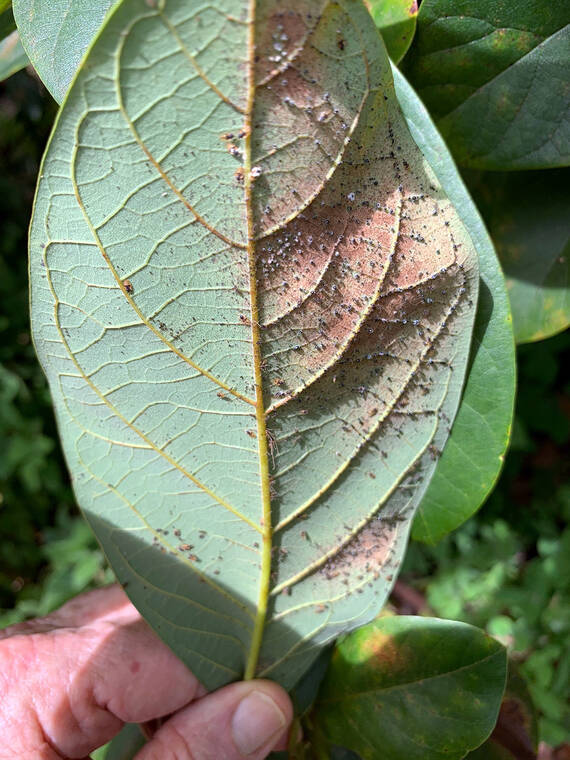Avocado trees all over the island have been looking like they are dying.
The leaves turn brown prematurely and in many cases the trees lose all their leaves. This condition is likely caused by the avocado lace bug. This insect was first noted in December 2019 on Oahu and has spread throughout Hawaii Island in 2021. Lace bug infestations will probably reduce crop yields and may even kill trees weakened by other stresses like root damage, nutritional and water issues. Natural predators of the avocado lace bug are present in Hawaii, so this infestation may be corrected. If you decide to spray your trees with a pesticide, be sure it is cleared for use on avocado trees and don’t apply while the trees are in bloom or you will kill bees and other pollinators.
No Hawaiian garden is complete without an avocado tree for shade and fruit. It is unusual in having its stored food chiefly in the form of fat and protein instead of sugar as in nearly all other fruits.
The avocado is a native American fruit that was growing wild from Southern Mexico to Ecuador and the West Indies at the time of Columbus’ arrival. Avocados are now found on the markets all over the country at all times of the year. The major Florida crop comes on the market from June to February and the California crop from January to June. Hawaii has fruit all year round.
The avocado is borne on large evergreen trees with large, somewhat leathery leaves. This tree is tolerant of a wide range of soil types, but it must be provided with good drainage. Flowers are produced in late winter or spring, and the fruit matures in anywhere from 6 to 18 months, depending on location and variety.
The avocado is a little strange when it comes to sex and fertilization. For example, the flower opens and closes twice. At its first opening, every flower behaves as if it were a female flower only, able to be pollinated but not able to shed pollen. Then it closes for 12 to 24 hours, and when it opens again it is essentially a male flower, shedding pollen but usually no longer in condition to be pollinated. Furthermore, all of the flowers on a tree open and close almost at the same time and all the trees of a given variety behave just alike, and their flowers open or close together. This makes interplanting of two or three varieties a very important practice.
Even after more than 100 years of culture in Hawaii, there is no one variety or set of varieties that is wholly satisfactory. Each has its faults and advantages. Sharwil, Yamagata, Murashige, Ohata, and Kahaluu are local favorites.
If you are in a hurry, avoid seedlings and grow grafted trees. Seedlings grow quite tall and may take 7 to 12 years to bear fruit and then you may not get good quality fruit. Grafted trees are carried at some nurseries. Grafted trees, begin to bear in two years and are not as tall.
Avocados may be planted successfully at any season of the year but spring is the best time. Frequent irrigations are necessary though, until the tree is established. Remember that avocado trees do not like saline water or soggy soils. Choose a rich, well drained soil. Strong winds will cause leaves to burn or shed. If your soil is poor, mix in peat moss and well rotted manure to improve it.
Avocados are heavy feeders. The fertilizer should carry a high percentage of nitrogen with a good portion derived from organic sources. Good results are obtained under widely varying treatments. Newly planted trees should be fertilized at planting time with a 1-1-1 ratio fertilizer that has at least 30 percent of its nitrogen derived from natural organics. Fertilize according to label directions. Like most other fruits, you are bound to get bumper crops. Finding ways to incorporate this nutritious fruit into your family’s diet can be a chore.
The avocado pulp, that is easily prepared in a blender, freezes well, if pineapple or lemon juice is added while being pureed. This pulp can be used in making a delicious bread or cake, by following a banana bread or cake recipe. The pulp can also be used to prepare a chilled summer soup that calls for two cups of condensed cream of chicken soup that has been heated to a smooth consistency and chilled. One half cup of pureed avocado, one half cup of cold milk and a dash of white pepper complete the soup. Stay healthy by including high quality local fruits like avocados in your diet.
Hopefully the Avocado Lace Bug infestation will soon be controlled naturally and abundant crops will soon be back.






